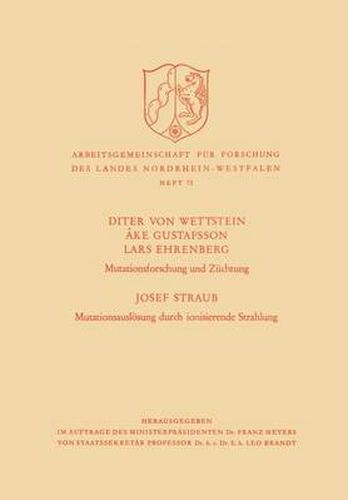Readings Newsletter
Become a Readings Member to make your shopping experience even easier.
Sign in or sign up for free!
You’re not far away from qualifying for FREE standard shipping within Australia
You’ve qualified for FREE standard shipping within Australia
The cart is loading…






This title is printed to order. This book may have been self-published. If so, we cannot guarantee the quality of the content. In the main most books will have gone through the editing process however some may not. We therefore suggest that you be aware of this before ordering this book. If in doubt check either the author or publisher’s details as we are unable to accept any returns unless they are faulty. Please contact us if you have any questions.
Applying ionizing radiations and chemical mutagens we are now in a better condition of regulating and predicting the change of cultivated species into organisms improved from an agricultural point of view. Either this takes place by mutation alone or by mutation as an addendum to hybridization and polyploidy. Irradiation can produce genotypes which Nature does not seem to have figured. Some induced chromosome changes, at least, have not yet been found in nature. Ionizing radiations, administered either in a chronical or acute manner, cause both gene mutations and chromosomal rearrangements. Depending on the physiological stage and the genetical constitution of the irradiated material, as well as on the selection technique involved, the mutation process can be changed qualitatively and quantitatively to a considerable extent. Applying chemical mutagens such as 8-ethoxycoffeine, nebularine or myleran we can differentiate between gene-mutations and chromosomal rearrangements. Chromosome breakage can be concentrated to heterochromatic regions or special structures of the chromosomes. Under the combined influence of ionizing radiations and chemical mutagens he- terochromatic and euchromatic breaks may be reunited in a fashion scarcely visualized before. With ethylene oxide and ethylene imine the frequency of factor-mutations - also viable and highly productive ones - can be increased 2-3 times above the highest mutation level achieved with ionizing radia- tions. Considerable specificity is found in the mutability and the mecha- nism of mutation in individual loci of barley depending on the ion density of the radiations used.
$9.00 standard shipping within Australia
FREE standard shipping within Australia for orders over $100.00
Express & International shipping calculated at checkout
This title is printed to order. This book may have been self-published. If so, we cannot guarantee the quality of the content. In the main most books will have gone through the editing process however some may not. We therefore suggest that you be aware of this before ordering this book. If in doubt check either the author or publisher’s details as we are unable to accept any returns unless they are faulty. Please contact us if you have any questions.
Applying ionizing radiations and chemical mutagens we are now in a better condition of regulating and predicting the change of cultivated species into organisms improved from an agricultural point of view. Either this takes place by mutation alone or by mutation as an addendum to hybridization and polyploidy. Irradiation can produce genotypes which Nature does not seem to have figured. Some induced chromosome changes, at least, have not yet been found in nature. Ionizing radiations, administered either in a chronical or acute manner, cause both gene mutations and chromosomal rearrangements. Depending on the physiological stage and the genetical constitution of the irradiated material, as well as on the selection technique involved, the mutation process can be changed qualitatively and quantitatively to a considerable extent. Applying chemical mutagens such as 8-ethoxycoffeine, nebularine or myleran we can differentiate between gene-mutations and chromosomal rearrangements. Chromosome breakage can be concentrated to heterochromatic regions or special structures of the chromosomes. Under the combined influence of ionizing radiations and chemical mutagens he- terochromatic and euchromatic breaks may be reunited in a fashion scarcely visualized before. With ethylene oxide and ethylene imine the frequency of factor-mutations - also viable and highly productive ones - can be increased 2-3 times above the highest mutation level achieved with ionizing radia- tions. Considerable specificity is found in the mutability and the mecha- nism of mutation in individual loci of barley depending on the ion density of the radiations used.